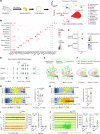A novel anti-epileptogenesis strategy of temporal lobe epilepsy based on nitric oxide donor
- PMID: 39653809
- PMCID: PMC11730642
- DOI: 10.1038/s44321-024-00168-1
A novel anti-epileptogenesis strategy of temporal lobe epilepsy based on nitric oxide donor
Abstract
The molecular mechanism underlying the role of hippocampal hilar interneuron degeneration in temporal lobe epilepsy (TLE) remains unclear. Especially, very few studies have focused on the role of neuronal nitric oxide synthase (nNOS, encoded by Nos1) containing hilar interneurons in TLE. In the present study, Nos1 conditional knockout mice were constructed, and we found that selective deletion of Nos1 in hilar interneurons rather than dentate granular cells (DGCs) triggered epileptogenesis. The level of nNOS was downregulated in patients and mice with TLE. Nos1 deletion led to excessive epilepsy-like excitatory input circuit formation and hyperexcitation of DGCs. Replenishment of hilar nNOS protein blocked epileptogenic development and memory impairment in pilocarpine-induced TLE mice. Moreover, chronic treatment with DETA/NONOate, a slowly released exogenous nitric oxide (NO) donor, prevented aberrant neural circuits of DGCs and the consequent epileptogenesis without acute antiseizure effects. Therefore, we concluded that NO donor therapy may be a novel anti-epileptogenesis strategy, different from existing antiseizure medications (ASMs), for curing TLE.
Keywords: Dentate Granule Cells; Epileptogenesis; Hilar Interneurons; Neuronal Nitric Oxide Synthase; Pilocarpine.
© 2024. The Author(s).
Conflict of interest statement
Disclosure and competing interests statement. The authors declare no competing interests.
Figures












Similar articles
-
Deficiency of nNOS in adult-born dentate granule cells causes epilepsy.Epilepsia Open. 2025 Aug 28. doi: 10.1002/epi4.70133. Online ahead of print. Epilepsia Open. 2025. PMID: 40874679
-
Decreased excitatory drive onto hilar neuronal nitric oxide synthase expressing interneurons in chronic models of epilepsy.Brain Res. 2021 Aug 1;1764:147467. doi: 10.1016/j.brainres.2021.147467. Epub 2021 Apr 5. Brain Res. 2021. PMID: 33831408
-
Inhibition of neuronal nitric oxide synthase protects against hippocampal neuronal injuries by increasing neuropeptide Y expression in temporal lobe epilepsy mice.Free Radic Biol Med. 2022 Aug 1;188:45-61. doi: 10.1016/j.freeradbiomed.2022.06.221. Epub 2022 Jun 15. Free Radic Biol Med. 2022. PMID: 35714846
-
The functional organization of the hippocampal dentate gyrus and its relevance to the pathogenesis of temporal lobe epilepsy.Ann Neurol. 1994 Jun;35(6):640-54. doi: 10.1002/ana.410350604. Ann Neurol. 1994. PMID: 8210220 Review.
-
Molecular neuropathology of temporal lobe epilepsy: complementary approaches in animal models and human disease tissue.Epilepsia. 2007;48 Suppl 2:4-12. doi: 10.1111/j.1528-1167.2007.01062.x. Epilepsia. 2007. PMID: 17571348 Review.
References
-
- Bauer JA, Booth BP, Fung HL (1995) Nitric oxide donors: biochemical pharmacology and therapeutics. Adv Pharmacol 34:361–381 - PubMed
-
- Brodie MJ (2017) Sodium channel blockers in the treatment of epilepsy. CNS Drugs 31:527–534 - PubMed
-
- Calabrese V, Mancuso C, Calvani M, Rizzarelli E, Butterfield DA, Stella AM (2007) Nitric oxide in the central nervous system: neuroprotection versus neurotoxicity. Nat Rev Neurosci 8:766–775 - PubMed
MeSH terms
Substances
Grants and funding
- 2022ZD0211700/STI2030-Major Projects
- 82071525/MOST | National Natural Science Foundation of China (NSFC)
- 82325048/MOST | National Natural Science Foundation of China (NSFC)
- 82001376/MOST | National Natural Science Foundation of China (NSFC)
- 82371458/MOST | National Natural Science Foundation of China (NSFC)
LinkOut - more resources
Full Text Sources

